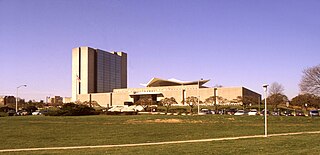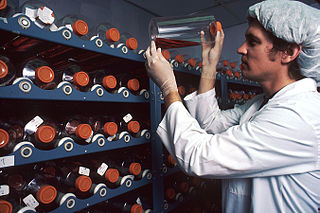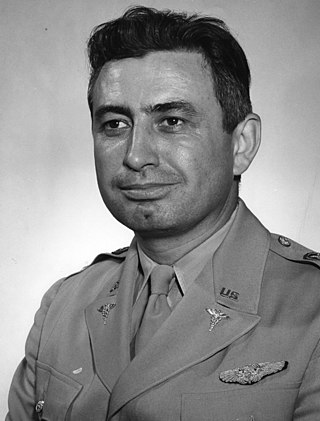
Huntingdon Life Sciences (HLS) was a contract research organisation (CRO) founded in 1951 in Cambridgeshire, England. It had two laboratories in the United Kingdom and one in the United States. With over 1,600 staff, it was until 2015 the largest non-clinical CRO in Europe. In September 2015, Huntingdon Life Sciences, Harlan Laboratories, GFA, NDA Analytics and LSR associates merged into Envigo, which later sold off the CRO part.

The United States National Library of Medicine (NLM), operated by the United States federal government, is the world's largest medical library.

Spirometry is the most common of the pulmonary function tests (PFTs). It measures lung function, specifically the amount (volume) and/or speed (flow) of air that can be inhaled and exhaled. Spirometry is helpful in assessing breathing patterns that identify conditions such as asthma, pulmonary fibrosis, cystic fibrosis, and COPD. It is also helpful as part of a system of health surveillance, in which breathing patterns are measured over time.

Chelation therapy is a medical procedure that involves the administration of chelating agents to remove heavy metals from the body. Chelation therapy has a long history of use in clinical toxicology and remains in use for some very specific medical treatments, although it is administered under very careful medical supervision due to various inherent risks, including the mobilization of mercury and other metals through the brain and other parts of the body by the use of weak chelating agents that unbind with metals before elimination, exacerbating existing damage. To avoid mobilization, some practitioners of chelation use strong chelators, such as selenium, taken at low doses over a long period of time.

Labcorp Drug Development is a contract research organization headquartered in Burlington, North Carolina, providing nonclinical, preclinical, clinical and commercialization services to pharmaceutical and biotechnology industries. Formerly called Covance, the company is part of Labcorp, which employs more than 70,000 people worldwide.

CX717 is an ampakine compound created by Christopher Marrs and Gary Rogers in 1996 at Cortex Pharmaceuticals. It affects the neurotransmitter glutamate, with trials showing the drug improves cognitive functioning and memory.

Medical research, also known as health research, refers to the process of using scientific methods with the aim to produce knowledge about human diseases, the prevention and treatment of illness, and the promotion of health.

William Randolph Lovelace II was an American physician who made contributions to aerospace medicine.

The Indian Council of Medical Research (ICMR), the apex body in India for the formulation, coordination and promotion of biomedical research, is one of the oldest and largest medical research bodies in the world.

Experiments involving non-human primates (NHPs) include toxicity testing for medical and non-medical substances; studies of infectious disease, such as HIV and hepatitis; neurological studies; behavior and cognition; reproduction; genetics; and xenotransplantation. Around 65,000 NHPs are used every year in the United States, and around 7,000 across the European Union. Most are purpose-bred, while some are caught in the wild.

Toxicology testing, also known as safety assessment, or toxicity testing, is the process of determining the degree to which a substance of interest negatively impacts the normal biological functions of an organism, given a certain exposure duration, route of exposure, and substance concentration.

Biomedical waste or hospital waste is any kind of waste containing infectious materials generated during the treatment of humans or animals as well as during research involving biologics. It may also include waste associated with the generation of biomedical waste that visually appears to be of medical or laboratory origin, as well research laboratory waste containing biomolecules or organisms that are mainly restricted from environmental release. As detailed below, discarded sharps are considered biomedical waste whether they are contaminated or not, due to the possibility of being contaminated with blood and their propensity to cause injury when not properly contained and disposed. Biomedical waste is a type of biowaste.
Allied Academies is a reportedly fraudulent corporation chartered under the laws of North Carolina. Its postal address is in London, United Kingdom. It presents itself as an association of scholars, with supporting and encouraging research and the sharing and exchange of knowledge as its stated aims. The organization consists of 30 affiliate academies, which provide awards to academics and publish academic journals both online and in hard copy for members. Since 2015 the organization has been listed on Jeffrey Beall's list of "potential, possible, or probable predatory scholarly open-access publishers". It is in a partnership with OMICS Publishing Group which uses its website and logo. In 2018, OMICS owner Srinubabu Gedela declared that he had informed the Nevada court that Allied Academies was a subsidiary of OMICS International. During a conference in 2018, they falsely listed a prominent chemist among its organizing committee who had not agreed to this and was not affiliated with Allied Academies.
CLARIO formerly ERT and Bioclinica is a contract research organization specializing in clinical services and customizable medical devices to biopharmaceutical and healthcare organizations. It offers centralized cardiac safety and respiratory efficacy services in drug development and also collects, analyzes and distributes electronic patient-reported outcomes (ePRO) in multiple modalities across all phases of clinical research.

Biomedical sciences are a set of sciences applying portions of natural science or formal science, or both, to develop knowledge, interventions, or technology that are of use in healthcare or public health. Such disciplines as medical microbiology, clinical virology, clinical epidemiology, genetic epidemiology, and biomedical engineering are medical sciences. In explaining physiological mechanisms operating in pathological processes, however, pathophysiology can be regarded as basic science.
The Rush Alzheimer's Disease Center (RADC) is an independent research center located in the Medical College of Rush University Medical Center. The Rush Alzheimer's Disease Center is one of the Alzheimer's Disease Research Centers in the U.S. designated and funded by the National Institute on Aging.
Intratracheal instillation is the introduction of a substance directly into the trachea. It is widely used to test the respiratory toxicity of a substance as an alternative to inhalation in animal testing. Intratracheal instillation was reported as early as 1923 in studies of the carcinogenicity of coal tar. Modern methodology was developed by several research groups in the 1970s. By contrast, tracheal administration of pharmaceutical drugs in humans is called endotracheal administration.
Clayton "Sam" Samuel White was an American physician, nuclear physicist, and medical researcher best known for developing the field of "blast and shock biology" which explored the effects of blast and shock waves from atomic bombs and other explosions. By bringing together the disciplines of mathematics, physics, biology, and anatomy, White measured the impact of atomic weapons on physical structures and the human body.

Lovelace Health System is a healthcare company which operates six hospitals in New Mexico, five in Albuquerque and one in Roswell. It is one of New Mexico's largest employers with 3,659 employees as of 2020. The company grew out of the Lovelace Clinic founded in 1922, one of the pioneers of group medical practice in the United States. The clinic was best known for conducting physical evaluations of 32 astronaut candidates in 1959 which helped to select the Mercury Seven, the first Americans to travel into space. The clinic also administered testing for an unofficial "women in space" program, during which 13 women—later nicknamed the Mercury 13—were named as prospective astronauts, though they never traveled to space.
Pennsylvania State College of Medicine (PSCOM), known simply as Penn State College of Medicine is the medical school of Pennsylvania State University, a public university system in Pennsylvania. It is located in Hershey near the Penn State Milton S. Hershey Medical Center and Penn State Health Children's Hospital, the medical school's principal affiliate. The medical school includes 26 basic science and clinical departments and a range of clinical programs conducted at its hospital affiliates and numerous ambulatory care sites in the region.














